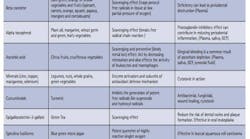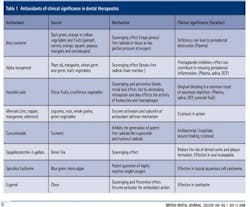By Jacqueline Russo, RN, DDS
The oral-systemic link has irrefutably been documented. As dental professionals we are all aware that the inflammation from periodontal disease is not a localized event but one with life-threatening global consequences. So the question that confounds us is how to incorporate the research into our practices as clinical protocol. Traditional therapies alone are frustratingly ineffective at resolving periodontal disease long term. The fact that periodontal disease exacerbates every inflammatory process in our body mandates that if we want to move our patients to long term health we must address the patient systemically. Screening for inflammatory biomarkers and oral pathogens, treating sleep apnea and having protocols for smoking cessation are lifesaving services that should be offered by dentists. Nutritional screening and counseling is another essential piece of the oral-systemic equation that cannot be ignored if we want to provide optimal care for our patients.There is increasing evidence that the link between periodontal and other inflammatory diseases is being driven by reactive oxygen species (ROS). The presence of periodontal pathogens leads to a hyper-inflammatory state and the formation of ROS. A leading hypothesis of aging is based on the free radical theory of aging by Harman(1) who argued that oxygen-free radicals produced cumulative damage to molecules which progressively leads to loss of functionality of the organism. These same free radicals create oxidative stress induced damage to gingiva, periodontal ligament and alveolar bone.(2) There is extensive research showing that antioxidants play a vital role in minimizing oxidative damage caused by free radicals. Iain Chappel recently published research in the JADA that stated: “Higher serum antioxidant concentrations were associated with lower odds ratios for severe periodontal disease.”(3) The table below from the British Journal of Nutrition(4) lists antioxidants of clinical significance in dentistry.
The oral-systemic link has irrefutably been documented. As dental professionals we are all aware that the inflammation from periodontal disease is not a localized event but one with life-threatening global consequences. So the question that confounds us is how to incorporate the research into our practices as clinical protocol. Traditional therapies alone are frustratingly ineffective at resolving periodontal disease long term. The fact that periodontal disease exacerbates every inflammatory process in our body mandates that if we want to move our patients to long term health we must address the patient systemically. Screening for inflammatory biomarkers and oral pathogens, treating sleep apnea and having protocols for smoking cessation are lifesaving services that should be offered by dentists. Nutritional screening and counseling is another essential piece of the oral-systemic equation that cannot be ignored if we want to provide optimal care for our patients.There is increasing evidence that the link between periodontal and other inflammatory diseases is being driven by reactive oxygen species (ROS). The presence of periodontal pathogens leads to a hyper-inflammatory state and the formation of ROS. A leading hypothesis of aging is based on the free radical theory of aging by Harman(1) who argued that oxygen-free radicals produced cumulative damage to molecules which progressively leads to loss of functionality of the organism. These same free radicals create oxidative stress induced damage to gingiva, periodontal ligament and alveolar bone.(2) There is extensive research showing that antioxidants play a vital role in minimizing oxidative damage caused by free radicals. Iain Chappel recently published research in the JADA that stated: “Higher serum antioxidant concentrations were associated with lower odds ratios for severe periodontal disease.”(3) The table below from the British Journal of Nutrition(4) lists antioxidants of clinical significance in dentistry.
A recent article in The Journal of Clinical Periodontology concluded that for prevention and treatment of periodontitis, daily nutrition should include sufficient amounts of antioxidants, Vitamin D and Calcium.(5) Hundreds of articles on antioxidants and oral health, overall health and prevention of disease can be researched at www.pubmed.org so for the purpose of this article we will assume the oral health and overall benefit of antioxidants. We are what we eat and in this country that does not bode well for many Americans. We have the highest incidence of metabolic syndrome of any industrialized country in spite of the availability of high quality food sources. In this author’s opinion, every dental practitioner should be discussing nutrition with their patients as a key component of the health questionnaire during the comprehensive examination. A basic understanding of the role antioxidants play in health is essential to aid us in discussing nutrition with our patients. A recommended diet consisting of good macro and micro-nutrients including the consumption of plentiful plant based antioxidants and phytonutrients is ideal.(6)Antioxidants are micronutrients sourced from our food from colorful fruits and vegetables and pharmaceutical grade supplements. A list of the best 20 food sources for antioxidants follows:1. Small red beans 2. Wild blueberries3. Kidney beans4. Pinto beans5. Blueberries6. Cranberries7. Artichokes8. Blackberries9. Prunes10. Raspberries 11. Strawberries 12. Red Delicious, GS apples 13. Pecans 14. Sweet cherries 15. Black plums 16. Russet potatoes 17. Black beans 18. Plums 19. Gala apples 20. Walnuts The nutrients from these foods limit oxidative tissue damage by neutralizing free radicals or ROS and preventing the oxidation of our cells. By preventing cellular and DNA damage from free radicals, we reduce the inflammatory burden on the entire body and effectively enhance immune function, and improve our patients overall health.(6) So how do we implement nutrition into our already busy practices? We need to be able to measure nutritional levels in the body. We could assume that everyone is nutritional deficient, and probably be right most of the time, but that is not science. Traditionally, obtaining a biomarker for nutrition has been expensive and invasive, only blood or tissue sampling was available. However, obtaining an inexpensive and non-invasive measurement of antioxidant status is now possible with a device called the Biophotonic Scanner. This technology inexpensively and more accurately than blood serum testing can measure antioxidant status in the body in 90 seconds. It is critical in dentistry or medicine to have a way to measure effectiveness of therapies. Up until now there have been limited ways to monitor our patients’ nutritional status so many practitioners have not understood how effective nutritional intervention can be. This technology was recently introduced on the Dr. Oz show as the ultimate nutritional lie detector test. He told the audience he was astounded by the results and the technology completely blew his mind. See the video at www.doctoroz.com/videos/cancer-fighting-antioxidants-pt-1.The ability to measure and monitor nutritional status will enable us to make nutritional recommendations that will enhance our treatment outcomes and improve our patients lives. We see our patients on a more regular basis than any other health care provider. In fact, in some cases, we might be the ONLY health care provider they see. We have a unique opportunity to influence our patients to live their very best lives. Now that is something to get excited about!References
1. Harman, D. Aging: a theory based on free radical and radiation chemistry. J. Gerontology 1956, July:11(3):298-300.2. Soory, Mena: Redox status in periodontal and systemic inflammatory conditions including associated neoplasias: antioxidants as adjunctive therapy? Infectious Disorders-DrugTargets 2009, 9, 415-427.3. Chapple, Iain et al: The prevalence of inflammatory periodontal disease is negatively associated with serum antioxidant concentrations. Journal of Nutrition. 137:657-664, 2007.4. Carnelio, S et al: Definite, probable or dubious: antioxidants trilogy in clinical dentistry. British Dental Journal, Volume 204, Jan:2008:29.5. Van der Velden U, Kuzmanova D, Chapple IL:. Micronutritional approaches to periodontal therapy. J Clin Periodontol. 2011 Mar;38 Suppl 11:142-58.6. Lester Packer, PhD, and Carol Colman. “The Antioxidant Miracle”, John Wiley & Sons, 1999.
1. Harman, D. Aging: a theory based on free radical and radiation chemistry. J. Gerontology 1956, July:11(3):298-300.2. Soory, Mena: Redox status in periodontal and systemic inflammatory conditions including associated neoplasias: antioxidants as adjunctive therapy? Infectious Disorders-DrugTargets 2009, 9, 415-427.3. Chapple, Iain et al: The prevalence of inflammatory periodontal disease is negatively associated with serum antioxidant concentrations. Journal of Nutrition. 137:657-664, 2007.4. Carnelio, S et al: Definite, probable or dubious: antioxidants trilogy in clinical dentistry. British Dental Journal, Volume 204, Jan:2008:29.5. Van der Velden U, Kuzmanova D, Chapple IL:. Micronutritional approaches to periodontal therapy. J Clin Periodontol. 2011 Mar;38 Suppl 11:142-58.6. Lester Packer, PhD, and Carol Colman. “The Antioxidant Miracle”, John Wiley & Sons, 1999.
Dr. Jacqueline Russo graduated Indiana University School of Nursing and Baylor College of Dentistry in 1985. She is a founding member of the American Academy for Oral Systemic Health. She is a board member for the National Wellness Alliance and also the International Academy for Facial Esthetics. She can be reached at [email protected].








